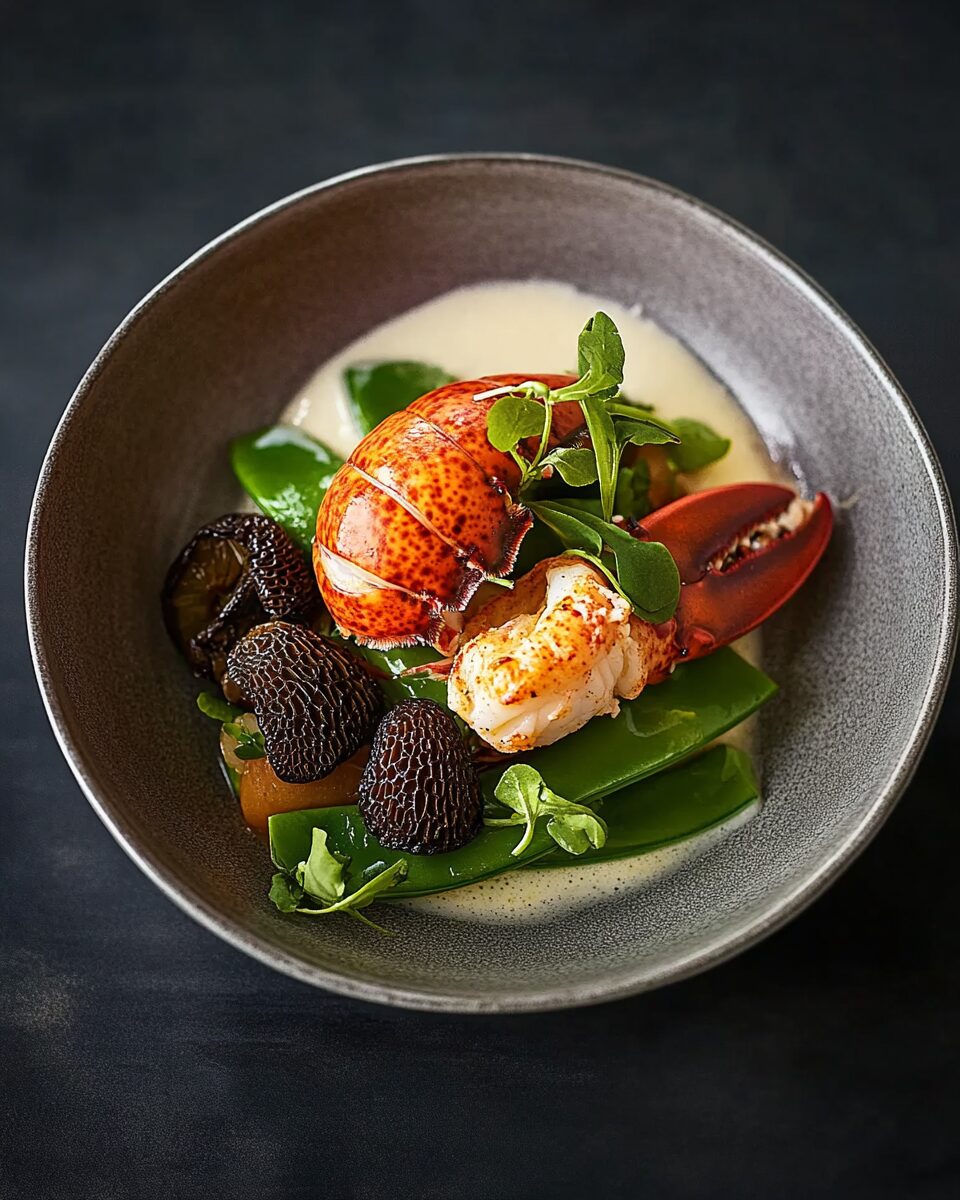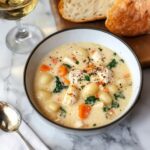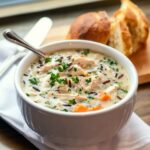Poached Lobster with Snap Peas and Morels is an exquisite dish that combines the delicate sweetness of lobster with the earthy flavors of morel mushrooms and the crisp freshness of sugar snap peas. This French-inspired recipe is elevated by a luxurious sherry sabayon, creating a harmonious blend of textures and tastes. While it requires a moderate to advanced level of culinary skill, the result is a restaurant-quality meal perfect for special occasions or gourmet home dining.
Full Recipe:
Ingredients
- Lobster:
- 4 lobsters, approximately 575 grams (1 ⅓ lb) each
- Sherry Sabayon:
- 15 grams dried morels
- 500 grams cold water
- 25 grams grapeseed oil
- 1 shallot, thinly sliced
- 250 grams cremini mushrooms, thinly sliced
- 30 grams sherry
- 4 sprigs thyme
- 1 egg
- 3 egg yolks
- 230 grams butter, melted
- 5 grams vin jaune
- 8 grams sherry vinegar
- Salt to taste
- Sugar Snap Peas:
- 12 whole sugar snap peas
- 120 grams shelled sugar snap peas
- 50 grams chicken stock
- 35 grams butter
- Salt to taste
- Braised Morels:
- 30 grams butter
- 36 morels
- ½ shallot, finely chopped
- 45 grams vin jaune
- 80 grams cream
- 50 grams sherry sabayon
- 25 grams lemon juice
- Salt to taste
- To Finish:
- Citrus beurre blanc
- Chive blossoms
- Fleur de sel
- Pea tendrils
- Miner’s lettuce
- 20 grams sabayon
Directions
- Prepare the Lobster: Begin by boiling a large pot of water and setting up an ice bath. Submerge the lobsters in boiling water, cover, and cook until the tails are opaque (about 2 minutes). Remove the lobsters, separate the claws and knuckles, and return these parts to the boiling water for an additional 3 minutes. Shock all parts in the ice bath, then carefully extract the meat, keeping it as intact as possible.
- Make the Sherry Sabayon: Soak dried morels in cold water for 2 hours. In a saucepan, sauté shallots in grapeseed oil until tender. Add cremini mushrooms and cook until caramelized. Deglaze with sherry, then add the soaked morels with their liquid and thyme. Simmer for 20 minutes, strain, and reduce the liquid by half. Whisk this reduction into a mixture of egg and egg yolks, then slowly incorporate melted butter, vin jaune, and sherry vinegar. Season with salt, transfer to an iSi canister, charge with N₂O, and cook in a water bath at 62°C (145°F) for 45 minutes.
- Prepare the Sugar Snap Peas: Blanch both whole and shelled snap peas in boiling water (20 seconds for whole, 10 seconds for shelled), then shock in ice water. In a sauté pan, heat chicken stock to a simmer, add butter to create a glaze, and toss in the blanched peas to warm through.
- Braise the Morels: Sauté morels in butter until they soften, add finely chopped shallots, and cook until tender. Deglaze with vin jaune, reduce, then add cream and cook to a thick glaze. Fold in sherry sabayon, season with lemon juice and salt.
- Finish the Dish: Heat citrus beurre blanc to 62°C (144°F) and warm the lobster meat in it for about 7 minutes. Drain and season with fleur de sel. Arrange the lobster, glazed snap peas, and braised morels in serving bowls. Garnish with chive blossoms, pea tendrils, and miner’s lettuce. Finish by adding 20 grams of sherry sabayon to each plate.
Nutritional Facts
Per serving (based on 4 servings):
- Calories: Approximately 650 kcal
- Protein: 45 g
- Fat: 45 g
- Saturated Fat: 25 g
- Carbohydrates: 20 g
- Fiber: 4 g
- Sugars: 6 g
- Cholesterol: 400 mg
- Sodium: 800 mg
The Origin of Lobster in Fine Dining
Lobster has long been considered a delicacy in fine dining, revered for its tender, sweet meat and luxurious qualities. Historically, lobster was not always seen as a luxury food. In colonial America, lobster was abundant and often considered a humble food, eaten primarily by the working class and sailors. It was only over time that lobster became associated with wealth and luxury, particularly as transportation and refrigeration improved, making it accessible to a wider audience.
In modern culinary circles, lobster is often featured in high-end restaurants and gourmet dishes, such as Poached Lobster with Snap Peas and Morels. Its versatility allows it to be paired with a variety of ingredients, from delicate herbs to rich sauces, making it a favorite among chefs seeking to create memorable and indulgent dishes.
The Importance of Fresh Lobster
When preparing Poached Lobster with Snap Peas and Morels, it is essential to use fresh lobster to ensure the best flavor and texture. Fresh lobster has a sweet, slightly briny taste and a firm texture that stands up well to poaching. The poaching process, when done correctly, helps retain the lobster’s natural moisture while enhancing its delicate flavor. If fresh lobster is unavailable, high-quality frozen lobster can be used as an alternative, though fresh is always preferred for its superior taste and texture.
Morel Mushrooms: A Delicacy of the Forest
Morel mushrooms are highly sought after for their unique flavor and appearance. Known for their honeycomb-like structure, morels are a wild mushroom that can be found in forests during the spring. Their earthy, nutty flavor pairs perfectly with rich proteins like lobster, making them a natural addition to this dish. Morels have a complex flavor profile, with hints of smokiness and woodiness, which add depth to the overall taste of the dish.
However, morels are not always easy to find, as they are seasonal and can be quite expensive. For those who are unable to find fresh morels, dried morels can be used as a substitute. Dried morels need to be rehydrated before cooking, but they still impart the same earthy flavor that makes them such a prized ingredient in dishes like Poached Lobster with Snap Peas and Morels.
Sugar Snap Peas: The Perfect Contrast
Sugar snap peas, with their crisp texture and sweet flavor, provide a fresh and vibrant contrast to the richness of the lobster and morels. These peas have a natural sweetness that balances the umami and earthiness of the other ingredients, creating a harmonious dish. Additionally, their bright green color adds visual appeal, making the dish not only delicious but also visually striking.
When preparing sugar snap peas, it is important to blanch them briefly to retain their crispness and bright color. Overcooking them can result in a mushy texture, which would detract from the overall quality of the dish. Blanching the peas in boiling water for just a few seconds, followed by an ice bath, helps preserve their natural sweetness and texture.
The Role of Sherry Sabayon
The sherry sabayon is a key component of Poached Lobster with Snap Peas and Morels, adding a rich and velvety texture to the dish. Sabayon, a classic French sauce made from eggs, butter, and wine, is known for its lightness and richness. In this recipe, the sabayon is flavored with sherry, a fortified wine that adds complexity and depth to the sauce.
To make the sabayon, the egg yolks are whisked together with sherry and cooked gently over a water bath until they become thick and creamy. The addition of melted butter creates a smooth, silky texture that envelops the lobster and vegetables in a luxurious coating. The sherry sabayon enhances the natural sweetness of the lobster and adds an extra layer of flavor to the dish.
Cooking Techniques for Poached Lobster
Poaching lobster is a technique that involves cooking the lobster gently in water or broth at a low temperature. This method helps preserve the delicate texture and flavor of the lobster, ensuring that it remains tender and moist. Poaching is often preferred over boiling, as boiling can cause the lobster to become tough and overcooked.
In Poached Lobster with Snap Peas and Morels, the lobster is briefly poached in boiling water, then cooled in an ice bath to stop the cooking process. The lobster meat is carefully extracted, taking care not to break it into pieces. The poached lobster is then finished in a citrus beurre blanc, which adds an extra layer of richness and flavor.
Pairing Poached Lobster with Wine
When it comes to pairing wine with Poached Lobster with Snap Peas and Morels, a white wine with a balanced acidity and complexity is the best choice. A Chardonnay, particularly one that has been lightly oaked, complements the richness of the lobster and the creamy texture of the sabayon. Alternatively, a crisp Sauvignon Blanc or a French white Burgundy would also pair beautifully, offering a fresh contrast to the richness of the dish.
For those who prefer red wine, a light Pinot Noir with subtle fruit flavors and low tannins can provide an interesting contrast to the dish’s richness without overpowering the lobster.
Conclusion
Poached Lobster with Snap Peas and Morels is a dish that epitomizes fine dining. With its carefully balanced flavors, luxurious textures, and the skillful use of premium ingredients, it offers a dining experience that is both indulgent and sophisticated. The poached lobster provides a sweet and tender base, complemented by the earthy richness of morel mushrooms and the fresh snap of sugar snap peas. The addition of sherry sabayon and citrus beurre blanc enhances the dish, creating a symphony of flavors that come together in perfect harmony.






